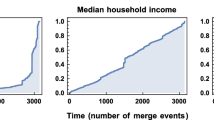Abstract
This paper presents a number of algorithms for a recently developed measure of space-time concordance. Based on a spatially explicit version of Kendall’s \(\tau \) the original implementation of the concordance measure relied on a brute force \(O(n^2)\) algorithm which has limited its use to modest sized problems. Several new algorithms have been devised which move this run time to \(O(n log(n) +np)\) where \(p\) is the expected number of spatial neighbors for each unit. Comparative timing of these alternative implementations reveals dramatic efficiency gains in moving away from the brute force algorithms. A tree-based implementation of the spatial concordance is also found to dominate a merge sort implementation.






Similar content being viewed by others
Notes
For an overview of this literature see Rey and Le Gallo (2009) and references cited therein.
The decomposition here is with respect to pairs of observations \((i,j)\). Other decompositional approaches in the literature are taken with respect to subsets of the observations \(i=1,2,\ldots ,n\). See for example, D’Agostino and Dardanoni (2009).
GDP per capita is expressed in constant 1995 basis pesos.
Additional simulations explored the impact of ties on the relative performance of the alternative approaches. Ties do not affect the main quantitative or qualitative findings reported here. Results are available upon request.
References
Abdi H (2007) The Kendall rank correlation coefficient. Encyclopedia of Measurement and Statistics Sage, Thousand Oaks, CA, pp 508–510
Boyle GE, McCarthy TG (1997) A simple measure of \(\beta \)-convergence. Oxf Bull Econ Stat XXVIII(1):155–211
Chapelle O, Sindhwani V, Keerthi S (2008) Optimization techniques for semi-supervised support vector machines. J Mach Learn Res 9:203–233
Cherubini U, Luciano E (2001) Value-at-risk trade-off and capital allocation with copulas. Econ Notes 30(2):235–256
Christensen D (2005) Fast algorithms for the calculation of Kendall’s \(\tau \). Comput Stat 20(1):51–62
Cuadrado-Roura J (2009) Regional policy, economic growth and convergence: lessons from the Spanish case. Springer, Berlin
D’Agostino M, Dardanoni V (2009) The measurement of rank mobility. J Econ Theory 144(4):1783–1803
Dardanoni V, Lambert P (2001) Horizontal inequity comparisons. Soc Choice Welf 18(4):799–816
Dwork C, Kumar R, Naor M, Sivakumar D (2001) Rank aggregation methods for the web. In: Proceedings of the 10th international conference on World Wide Web, ACM, pp 613–622
Fagin R, Kumar R, Sivakumar D (2003) Efficient similarity search and classification via rank aggregation. In: Proceedings of the 2003 ACM SIGMOD international conference on Management of data, ACM, pp 301–312
Fairbairn D (2006) Measuring map complexity. Cartogr J 43(3):224–238
Genest C, Nešlehová J (2011) Estimators based on Kendall’s Tau in multivariate copula models. Aust N Z J Stat 53(2):157–177
Glick B (1982) A spatial rank-order correlation measure. Geogr Anal 14(2):177–181
Jones E, Oliphant T, Peterson P, et al (2001) SciPy: Open source scientific tools for Python. http://www.scipy.org/
Kendall MG (1962) Rank correlation methods, 3rd edn. Griffin, London
Kepner W, Watts C, Edmonds C, Maingi J, Marsh S, Luna G (2000) A landscape approach for detecting and evaluating change in a semi-arid environment. Environ Monit Assess 64(1):179–195
Knight W (1966) A computer method for calculating Kendall’s Tau with ungrouped data. J Am Stat Assoc 61:436–439
Kundzewicz Z, Robson A (2004) Change detection in hydrological records: a review of the methodology/revue méthodologique de la détection de changements dans les chroniques hydrologiques. Hydrol Sci J 49(1):1–19
MacEachren A (1982) Map complexity: comparison and measurement. Cartogr Geogr Inf Sci 9(1):31–46
Nelsen R (1991) Copulas and association. In: DallÁglio G, Kotz S, Aalinetti G (eds) Advances in probability distributions with given marginals. Kluwer, Dordrecth, pp 51–74
Rey SJ (2004) Spatial dependence in the evolution of regional income distributions. In: Getis A, Múr J, Zoeller H (eds) Spatial econometrics and spatial statistics. Palgrave, Hampshire, pp 193–213
Rey SJ, Anselin L (2010) PySAL: a python library of spatial analytical methods. In: Fischer MM, Getis A (eds) Handbook of applied spatial analysis. Springer, Berlin, pp 175–193
Rey SJ, Le Gallo J (2009) Spatial analysis of economic convergence. In: Mills TC, Patterson K (eds) Handbook of econometrics, vol II. Applied EconometricsPalgrave Macmillan, New York, pp 1251–1290
Rey SJ, Sastré-Gutiérrez ML (2010) Interregional inequality dynamics in Mexico. Spatial Econ Anal 5(3):277–298
Schweizer B (1991) Thirty years of copulas. In: DallÁglio G, Kotz S, Aalinetti G (eds) Advances in probability distributions with given marginals. Kluwer, Dordrecth, pp 13–50
Author information
Authors and Affiliations
Corresponding author
Additional information
This research was funded by NSF Award OCI-1047916, SI2-SSI: CyberGIS Software Integration for Sustained Geospatial Innovation.
Rights and permissions
About this article
Cite this article
Rey, S.J. Fast algorithms for a space-time concordance measure. Comput Stat 29, 799–811 (2014). https://doi.org/10.1007/s00180-013-0461-2
Received:
Accepted:
Published:
Issue Date:
DOI: https://doi.org/10.1007/s00180-013-0461-2




